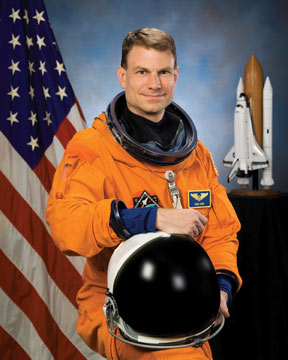|
DOWN TO EARTH WITH...: News about people from AGI and its 44 member societies
Archive of past profiles stories by date
Stanley Love
 NASA |
Astronomer and planetary scientist Stanley Love devoted his decade-long academic career to studying impact craters, asteroids and microscopic meteorites called interplanetary dust. But 10 years ago, Love left academia behind to pursue a dream. In 1998, he reported for duty as an astronaut.
Getting to space took some time. After completing his basic training, Love worked with NASA engineers to develop procedures for operating the International Space Station’s life-support systems and to design the next generation of spacecraft that will replace the space shuttle. For several years, he sat in Mission Control at the Johnson Space Center in Houston, Texas, as a Capsule Communicator (CAPCOM), the person responsible for communicating with astronauts over the radio during space missions.
Finally, a decade after joining NASA, Love reached outer space. Last February, Love boarded the space shuttle Atlantis to deliver the European Space Agency’s Columbus Laboratory to the International Space Station. During the mission, he completed two space walks to prepare the laboratory for installation and operated Atlantis’ robotic arm to inspect the shuttle’s heat shield.
A few months after traveling more than 8,524,424 kilometers during his 13-day mission, Love spoke with Geotimes reporter Erin Wayman.
EW: Did anything about space surprise you during your mission?
SL: Not really. Just about every aspect of the flight was something that I had been told about and prepared for. The only surprising thing that really stands out was when we got back. I was amazed at how dizzy I felt as my sense of balance readapted to gravity. It was really pretty dramatic.
EW: Is it likely that you’ll go on another space mission?
SL: It is certainly likely that I’ll have the chance. Right now, I just got back from one flight and flying in space is tough on families. So in the short term at least, I’m leaving it up to my wife and kids.
EW: Did an interest in space lead you to astronomy, or did your background in astronomy lead you to become an astronaut?
SL: I think there’s a hidden third variable. I’ve always just thought that exploration was really cool. Astronomy is a way of exploring space and the amazing universe that we are in. You can’t go there yourself because the distances are too great, but you can explore it using telescopes, spacecraft and other instruments. I was interested in that aspect of exploration. I was also interested, if there was a chance, in going in person. As it worked out, I had a chance to do that.
EW: When you were in college and graduate school, was that something you kept in the back of your mind?
SL: It was, although it wasn’t a hard goal at that point. I was studying astronomy, which I thought was cool. When I got my Ph.D., I became more of a planetary science person, so I added a little bit of geology to the astronomy. The job description at NASA said they were looking for that kind of background, so I just kept sending in applications every year.
EW: You applied more than once?
SL: Yes. When you apply, they ask you to update your application every year. I went through seven application cycles. If they like the look of your application, they’ll invite you down to interview. You spend a week getting all kinds of medical tests and interviews. I interviewed in 1994, and they said no thanks. Then they did another selection in 1995. I went down again for that, and they said no thanks. [Laughs] They finally decided to hire me in 1997. I reported for work in ’98.
EW: If NASA gave you free range to design your own exploration mission, what would it entail?
SL: I’m probably going to make myself unpopular with this answer, but I think the moon is really cool. The moon is so close and it’s got the same surface area as North America. We have visited a few tiny little spots. There’s a ton more to learn and do on the moon. If we go [back] there, it’ll make our future Mars experience that much more interesting.
EW: What’s the best part about being in space?
SL: Looking at the Earth. The Earth is the most interesting thing in space. Our work schedule is very challenging. But when there’s a moment to look out the window, it’s never a disappointing experience.

 Subscribe
Subscribe


